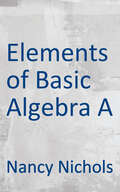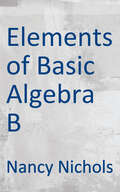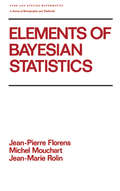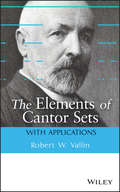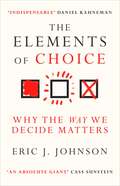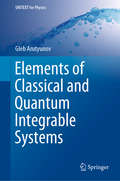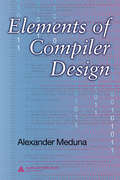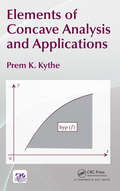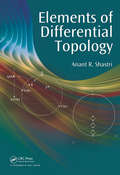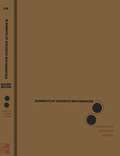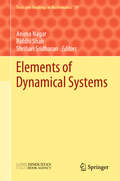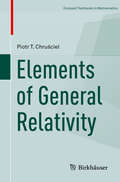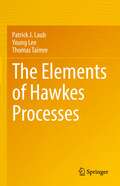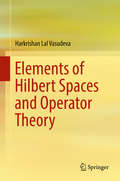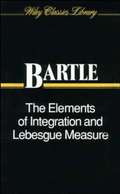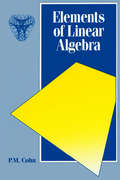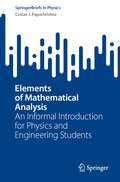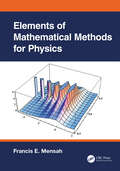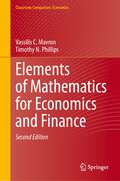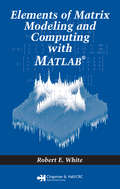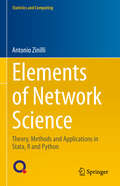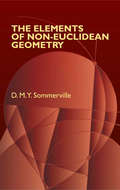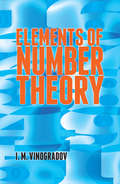- Table View
- List View
Elements of Bayesian Statistics
by Jean-Pierre FlorensThe ingratiating title notwithstanding, this is in no standard sense a text but a monograph, based largely upon the authors' research over a period of years, and intended to be read by sophisticated students of theoretical statistics.
The Elements of Cantor Sets--with Applications
by Robert W. VallinA systematic and integrated approach to Cantor Sets and their applications to various branches of mathematics The Elements of Cantor Sets: With Applications features a thorough introduction to Cantor Sets and applies these sets as a bridge between real analysis, probability, topology, and algebra. The author fills a gap in the current literature by providing an introductory and integrated perspective, thereby preparing readers for further study and building a deeper understanding of analysis, topology, set theory, number theory, and algebra. The Elements of Cantor Sets provides coverage of: Basic definitions and background theorems as well as comprehensive mathematical details A biography of Georg Ferdinand Ludwig Philipp Cantor, one of the most significant mathematicians of the last century Chapter coverage of fractals and self-similar sets, sums of Cantor Sets, the role of Cantor Sets in creating pathological functions, p-adic numbers, and several generalizations of Cantor Sets A wide spectrum of topics from measure theory to the Monty Hall Problem An ideal text for courses in real analysis, topology, algebra, and set theory for undergraduate and graduate-level courses within mathematics, computer science, engineering, and physics departments, The Elements of Cantor Sets is also appropriate as a useful reference for researchers and secondary mathematics education majors.
The Elements of Choice: Why the Way We Decide Matters
by Eric J. Johnson&‘Indispensable&’ Daniel Kahneman How do you get people to donate their organs? What&’s the trick to reading a wine list? What&’s the perfect number of potential matches a dating site should offer? Every time we make a choice, our minds go through an elaborate process most of us never even notice. We&’re influenced by subtle aspects of the way the choice is presented that often make the difference between a good decision and a bad one. To overcome the common faults in our decision-making and enable better choices in any situation involves conscious and intentional decision design. Transcending the familiar concepts of nudges and defaults, The Elements of Choice offers a comprehensive, systematic guide to creating effective choice architectures, the environments in which we make decisions. The designers of decisions need to consider all the elements involved in presenting a choice: how many options to offer, how to present those options, how to account for our natural cognitive shortcuts, and much more. These levers are unappreciated, yet they impact our reasoning every day. This book doesn&’t simply analyse the mental fallacies that trip us up. It goes further to show us what good decision-making looks like – that it can be both moral and effective.
Elements of Classical and Quantum Integrable Systems (UNITEXT for Physics)
by Gleb ArutyunovIntegrable models have a fascinating history with many important discoveries that dates back to the famous Kepler problem of planetary motion. Nowadays it is well recognised that integrable systems play a ubiquitous role in many research areas ranging from quantum field theory, string theory, solvable models of statistical mechanics, black hole physics, quantum chaos and the AdS/CFT correspondence, to pure mathematics, such as representation theory, harmonic analysis, random matrix theory and complex geometry. Starting with the Liouville theorem and finite-dimensional integrable models, this book covers the basic concepts of integrability including elements of the modern geometric approach based on Poisson reduction, classical and quantum factorised scattering and various incarnations of the Bethe Ansatz. Applications of integrability methods are illustrated in vast detail on the concrete examples of the Calogero-Moser-Sutherland and Ruijsenaars-Schneider models, the Heisenberg spin chain and the one-dimensional Bose gas interacting via a delta-function potential. This book has intermediate and advanced topics with details to make them clearly comprehensible.
Elements of Compiler Design
by Alexander MedunaMaintaining a balance between a theoretical and practical approach to this important subject, Elements of Compiler Design serves as an introduction to compiler writing for undergraduate students. From a theoretical viewpoint, it introduces rudimental models, such as automata and grammars, that underlie compilation and its essential phases. Based on
Elements of Concave Analysis and Applications
by Prem K. KytheConcave analysis deals mainly with concave and quasi-concave functions, although convex and quasi-convex functions are considered because of their mutual inherent relationship. The aim of Elements of Concave Analysis and Applications is to provide a basic and self‐contained introduction to concepts and detailed study of concave and convex functions. It is written in the style of a textbook, designed for courses in mathematical economics, finance, and manufacturing design. The suggested prerequisites are multivariate calculus, ordinary and elementary PDEs, and elementary probability theory.
Elements of Differential Topology
by Anant R. ShastriDerived from the author's course on the subject, Elements of Differential Topology explores the vast and elegant theories in topology developed by Morse, Thom, Smale, Whitney, Milnor, and others. It begins with differential and integral calculus, leads you through the intricacies of manifold theory, and concludes with discussions on algebraic topol
Elements of Discrete Mathematics - Second Edition
by C L LiuElements of Discrete Mathematics, Second Edition" by C. L. Liu is a comprehensive and accessible textbook that explores fundamental concepts in discrete mathematics. The book covers topics such as logic, set theory, combinatorics, graph theory, and mathematical induction, providing a solid foundation for students studying computer science, engineering, or mathematics. The author emphasizes clear explanations and examples to help readers grasp abstract concepts, making it suitable for both beginners and those seeking a deeper understanding of the subject. With its practical applications in computer science and information technology, the book serves as an essential resource for students and professionals alike, fostering a strong understanding of discrete mathematical structures and their significance in various disciplines.
Elements of Dynamical Systems (Texts and Readings in Mathematics #79)
by Anima Nagar Riddhi Shah Shrihari SridharanThis book stems from lectures that were delivered at the three-week Advanced Instructional School on Ergodic Theory and Dynamical Systems held at the Indian Institute of Technology Delhi, from 4–23 December 2017, with the support of the National Centre for Mathematics, National Board for Higher Mathematics, Department of Atomic Energy, Government of India. The book discusses various aspects of dynamical systems. Each chapter of this book specializes in one aspect of dynamical systems and thus begins at an elementary level and goes on to cover fairly advanced material. The book helps researchers be familiar with and navigate through different parts of ergodic theory and dynamical systems.
Elements of General Relativity (Compact Textbooks in Mathematics)
by Piotr T. ChruścielThis book provides an introduction to the mathematics and physics of general relativity, its basic physical concepts, its observational implications, and the new insights obtained into the nature of space-time and the structure of the universe. It introduces some of the most striking aspects of Einstein's theory of gravitation: black holes, gravitational waves, stellar models, and cosmology. It contains a self-contained introduction to tensor calculus and Riemannian geometry, using in parallel the language of modern differential geometry and the coordinate notation, more familiar to physicists. The author has strived to achieve mathematical rigour, with all notions given careful mathematical meaning, while trying to maintain the formalism to the minimum fit-for-purpose. Familiarity with special relativity is assumed. The overall aim is to convey some of the main physical and geometrical properties of Einstein's theory of gravitation, providing a solid entry point to further studies of the mathematics and physics of Einstein equations.
The Elements of Hawkes Processes
by Patrick J. Laub Young Lee Thomas TaimreHawkes processes are studied and used in a wide range of disciplines: mathematics, social sciences, and earthquake modelling, to name a few. This book presents a selective coverage of the core and recent topics in the broad field of Hawkes processes. It consists of three parts. Parts I and II summarise and provide an overview of core theory (including key simulation methods) and inference methods, complemented by a selection of recent research developments and applications. Part III is devoted to case studies in seismology and finance that connect the core theory and inference methods to practical scenarios. This book is designed primarily for applied probabilists, statisticians, and machine learners. However, the mathematical prerequisites have been kept to a minimum so that the content will also be of interest to undergraduates in advanced mathematics and statistics, as well as machine learning practitioners. Knowledge of matrix theory with basics of probability theory, including Poisson processes, is considered a prerequisite. Colour-blind-friendly illustrations are included.
Elements of Hilbert Spaces and Operator Theory
by Harkrishan Lal VasudevaThe book presents an introduction to the geometry of Hilbert spaces and operator theory, targeting graduate and senior undergraduate students of mathematics. Major topics discussed in the book are inner product spaces, linear operators, spectral theory and special classes of operators, and Banach spaces. On vector spaces, the structure of inner product is imposed. After discussing geometry of Hilbert spaces, its applications to diverse branches of mathematics have been studied. Along the way are introduced orthogonal polynomials and their use in Fourier series and approximations. Spectrum of an operator is the key to the understanding of the operator. Properties of the spectrum of different classes of operators, such as normal operators, self-adjoint operators, unitaries, isometries and compact operators have been discussed. A large number of examples of operators, along with their spectrum and its splitting into point spectrum, continuous spectrum, residual spectrum, approximate point spectrum and compression spectrum, have been worked out. Spectral theorems for self-adjoint operators, and normal operators, follow the spectral theorem for compact normal operators. The book also discusses invariant subspaces with special attention to the Volterra operator and unbounded operators. In order to make the text as accessible as possible, motivation for the topics is introduced and a greater amount of explanation than is usually found in standard texts on the subject is provided. The abstract theory in the book is supplemented with concrete examples. It is expected that these features will help the reader get a good grasp of the topics discussed. Hints and solutions to all the problems are collected at the end of the book. Additional features are introduced in the book when it becomes imperative. This spirit is kept alive throughout the book.
The Elements of Integration and Lebesgue Measure (Wiley Classics Library #92)
by Robert G. BartleConsists of two separate but closely related parts. Originally published in 1966, the first section deals with elements of integration and has been updated and corrected. The latter half details the main concepts of Lebesgue measure and uses the abstract measure space approach of the Lebesgue integral because it strikes directly at the most important results—the convergence theorems.
Elements of Linear Algebra (Chapman Hall/crc Mathematics Ser. #8)
by P.M. CohnThis volume presents a thorough discussion of systems of linear equations and their solutions. Vectors and matrices are introduced as required and an account of determinants is given. Great emphasis has been placed on keeping the presentation as simple as possible, with many illustrative examples. While all mathematical assertions are proved, the student is led to view the mathematical content intuitively, as an aid to understanding.The text treats the coordinate geometry of lines, planes and quadrics, provides a natural application for linear algebra and at the same time furnished a geometrical interpretation to illustrate the algebraic concepts.
Elements of Logical Reasoning
by Jan Von Plato Aptara. IncSome of our earliest experiences of the conclusive force of an argument come from school mathematics: faced with a mathematical proof, we cannot deny the conclusion once the premises have been accepted. Behind such arguments lies a more general pattern of 'demonstrative arguments' that is studied in the science of logic. Logical reasoning is applied at all levels, from everyday life to advanced sciences, and a remarkable level of complexity is achieved in everyday logical reasoning, even if the principles behind it remain intuitive. Jan von Plato provides an accessible but rigorous introduction to an important aspect of contemporary logic: its deductive machinery. He shows that when the forms of logical reasoning are analysed, it turns out that a limited set of first principles can represent any logical argument. His book will be valuable for students of logic, mathematics and computer science.
Elements of Mathematical Analysis: An Informal Introduction for Physics and Engineering Students (SpringerBriefs in Physics)
by Costas J. PapachristouThis book provides a comprehensive yet informal introduction to differentiating and integrating real functions with one variable. It also covers basic first-order differential equations and introduces higher-dimensional differentiation and integration. The focus is on significant theoretical proofs, accompanied by illustrative examples for clarity. A comprehensive bibliography aids deeper understanding. The concept of a function's differential is a central theme, relating to the "differential" within integrals. The discussion of indefinite integrals (collections of antiderivatives) precedes definite integrals, naturally connecting the two. The Appendix offers essential math formulas, exercise properties, and an in-depth exploration of continuity and differentiability. Select exercise solutions are provided. This book suits short introductory math courses for novice physics/engineering students. It equips them with vital differential and integral calculus tools for real-world applications. It is also useful for first-year undergraduates, reinforcing advanced calculus foundations for better Physics comprehension.
Elements of Mathematical Methods for Physics
by Francis E. MensahElements of Mathematical Methods for Physics provides students with an approachable and innovative introduction to key concepts of mathematical physics, accompanied by clear and concise explanations, relevant real-world examples and problems that help them to master the fundamentals of mathematical physics. The topics are presented at a basic level, for students lacking a prior mathematical background.This book is designed to be covered in two semesters, presenting 18 chapters on topics varying from differential equations, matrix algebra and tensor analysis to Fourier transform, including special functions and dynamical systems.Upper-level undergraduate and graduate students of physics and engineering as well as professionals will gain a better grip of the basics and a deeper insight into and appreciation for mathematical methods for physics.Key Features:• Reviews and presents the basic math skills needed at the undergraduate level.• Chapters accompanied by examples and end-of-chapter problems to enhance understanding.• Introduces dynamical systems and includes a chapter on Hilbert Space
Elements of Mathematics for Economics and Finance (Classroom Companion: Economics)
by Vassilis C. Mavron Timothy N. PhillipsThis book equips undergraduates with the mathematical skills required for degree courses in economics, finance, management, and business studies. The fundamental ideas are described in the simplest mathematical terms, highlighting threads of common mathematical theory in the various topics. Coverage helps readers become confident and competent in the use of mathematical tools and techniques that can be applied to a range of problems.
The Elements of Matlab® Style
by Richard K. JohnsonThe Elements of MATLAB Style is a guide for both new and experienced MATLAB programmers. It provides a comprehensive collection of standards and guidelines for creating solid MATLAB code that will be easy to understand, enhance, and maintain. It is written for both individuals and those working in teams in which consistency is critical. This is the only book devoted to MATLAB style and best programming practices, focusing on how MATLAB code can be written in order to maximize its effectiveness. Just as Strunk and White's The Elements of Style provides rules for writing in the English language, this book provides conventions for formatting, naming, documentation, programming and testing. It includes many concise examples of correct and incorrect usage, as well as coverage of the latest language features. The author also provides recommendations on use of the integrated development environment features that help produce better, more consistent software.
Elements of Matrix Modeling and Computing with MATLAB
by Robert E. WhiteAs discrete models and computing have become more common, there is a need to study matrix computation and numerical linear algebra. Encompassing a diverse mathematical core, Elements of Matrix Modeling and Computing with MATLAB examines a variety of applications and their modeling processes, showing you how to develop matrix models and solve algebr
Elements of Network Science: Theory, Methods and Applications in Stata, R and Python (Statistics and Computing)
by Antonio ZinilliThis book provides readers with a comprehensive guide to designing rigorous and effective network science tools using the statistical software platforms Stata, R, and Python. Network science offers a means to understand and analyze complex systems that involve various types of relationships. This text bridges the gap between theoretical understanding and practical application, making network science more accessible to a wide range of users. It presents the statistical models pertaining to individual network techniques, followed by empirical applications that use both built-in and user-written packages, and reveals the mathematical and statistical foundations of each model, along with demonstrations involving calculations and step-by-step code implementation. In addition, each chapter is complemented by a case study that illustrates one of the several techniques discussed. The introductory chapter serves as a roadmap for readers, providing an initial understanding of network science and guidance on the required packages, the second chapter focuses on the main concepts related to network properties. The next two chapters present the primary definitions and concepts in network science and various classes of graphs observed in real contexts. The final chapter explores the main social network models, including the family of exponential random graph models. Each chapter includes real-world data applications from the social sciences, using at least one of the platforms Stata, R, and Python, providing a more comprehensive understanding of the availability of network science methods across different software platforms. The underlying computer code and data sets are available online. The book will appeal to graduate students, researchers and data scientists, mainly from the social sciences, who seek theoretical and applied tools to implement network science techniques in their work.
The Elements of Non-Euclidean Geometry
by D. M.Y. SommervilleThis volume became the standard text in the field almost immediately upon its original publication. Renowned for its lucid yet meticulous exposition, it can be appreciated by anyone familiar with high school algebra and geometry. Its arrangement follows the traditional pattern of plane and solid geometry, in which theorems are deduced from axioms and postulates. In this manner, students can follow the development of non-Euclidean geometry in strictly logical order, from a fundamental analysis of the concept of parallelism to such advanced topics as inversion and transformations.Topics include elementary hyperbolic geometry; elliptic geometry; analytic non-Euclidean geometry; representations of non-Euclidean geometry in Euclidean space; and space curvature and the philosophical implications of non-Euclidean geometry. Additional subjects encompass the theory of the radical axes, homothetic centers, and systems of circles; inversion, equations of transformation, and groups of motions; and the classification of conics.Although geared toward undergraduate students, this text treats such important and difficult topics as the relation between parataxy and parallelism, the absolute measure, the pseudosphere, Gauss’ proof of the defect-area theorem, geodesic representation, and other advanced subjects. In addition, its 136 problems offer practice in using the forms and methods developed in the text.
Elements of Number Theory
by I. M. Vinogradov"A very welcome addition to books on number theory."--Bulletin, American Mathematical SocietyClear and detailed in its exposition, this text can be understood by readers with no background in advanced mathematics; only a small part requires a working knowledge of calculus. One of the most valuable characteristics of this book is its stress on learning number theory by means of demonstrations and problems. More than 200 problems and full solutions appear in the text, plus 100 numerical exercises. Some of these exercises deal with estimation of trigonometric sums and are especially valuable as introductions to more advanced studies. Translation of 1949 Russian edition.
